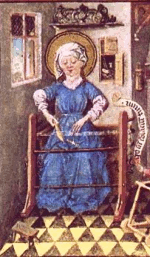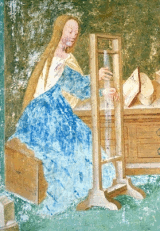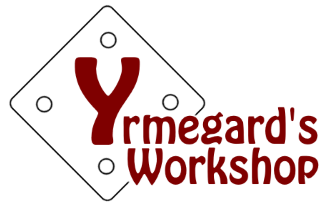Wide bands, looms and tablets
Not long ago, a rather fascinating topic came up in one of the tablet weaving communities: how, and with what equipment, were wide tablet-woven bands made in the Middle Ages?
Among the surviving examples of historical tablet-woven bands, there are both very wide ones and relatively narrow ones woven with a large number of tablets – 100 or more. Considering the materials that tablets were historically made of, they couldn’t have been very thin. Even modern tablets made from thin plastic form a hefty stack when you’ve got 100 of them. Working with so many tablets in one pack is simply impractical. But the real question isn’t that – it’s what kind of loom was used for weaving such bands.

In visual sources, we usually see two types of looms: the “Oseberg loom” and the “box loom”. The first gets its name from the sunken Oseberg ship, which contained a loom with a weaving in progress (dated to the 8th century). The Oseberg loom consists of two vertical posts connected by horizontal beams. The warp is stretched between the posts, and the weaver sits at the side. A later example of this loom type appears in the left image (a miniature from the Hours of Catherine of Cleves, dated 1440, depicting the Holy Family).

The second, more compact type is a box loom with horizontal rotating beams onto which the warp is wound. This “box” is shown in the right-hand image (a fragment of a tapestry dated to the 1500s; a full image is available on the Louvre’s website).
The compact box loom makes working with large numbers of tablets impossible – they simply won’t fit. The Oseberg-type loom has space, but in practice, large packs of tablets destabilise the warp and turn over. Moreover, keeping even tension across the threads and forming a clear shed becomes problematic. In short — all the ingredients for making the job harder.
One potential solution is to place a table or other horizontal support under the tablets, so they rest on it. This helps stabilise the warp and reduces the risk of tablet pack falling apart, but it doesn’t solve the issues of uneven tension or difficult to find shed.

Another potential solution is to use a completely different kind of loom. Vertical looms were well known by then, and warps tensioned with weights allow for unlimited width while maintaining consistent tension.
It turns out that depictions of vertical looms do exist, albeit rarely. For example, a fresco in the Church of Saints Primus and Felician in Slovenia shows Mary sitting at just such a loom (a larger image is available via the IMAREAL database). In this case, the threads are tensioned between two horizontal bars rather than with weights, but still, the setup allows for a broader distribution of the warp, making it much easier to work with many tablets. There is one caveat, though: based on the image alone, we can’t be sure what kind of weaving technique the loom was actually used for…
So, yet another mystery in the series of “How it really was.”
